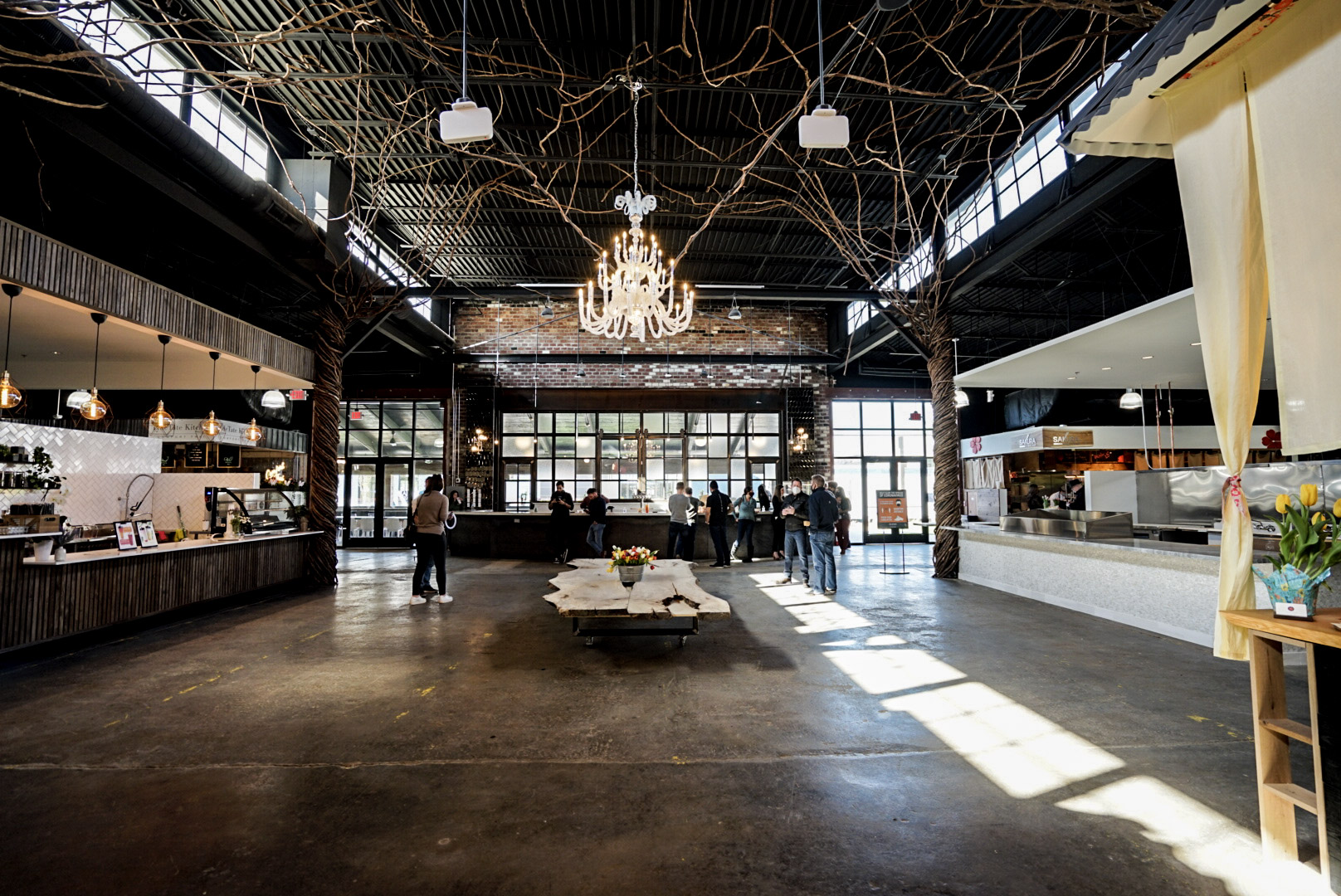At Shea, we pride ourselves on staying on top of what’s happening in design news. It helps us keep tabs on what’s fresh, inspiring, and happening in the world—and we make a few headlines of our own, too. Here are some recent articles delving into design, experience, and what’s buzzing in our community:
“Food Halls Position for the Future” – Foodservice Equipment + Supplies:
The food hall boom isn’t over in the United States—many survived through the pandemic due to their flexibility and are back to full operations. This piece discusses some of the reasons for food-hall development, how they differ from food courts, and how they can serve as incubators for local businesses and up-and-comers. To keep themselves flexible, food halls need to be designed with multi-use, standard equipment and blank-shell design in place that’s easy to transition between vendors. And food halls can be created within different spaces to help ensure their longevity with a built-in audience, like in office developments, hotels, casinos, and stadiums.
“Shea Projects Score Three MSCA STARR Awards” – Shea:
The full list of MSCA STARR Award winners, including Vivir, Saint City Running, and Sidebar at Surdyk’s.
“The Corner Store, Curated” – Eater:
As small food brands have cropped up over the last five years, particularly in the last two, and have been spreading their ethos via ads and social media, new corner stores are giving them a place to come together in a brick-and-mortar space. Filled with quirky, lesser-known brands, these upmarket shops are flourishing with an influx of new consumer packaged goods brands that have attractive packaging and give spaces a curated feel just by being on the shelves. These shops appeal to brands because they’re less expensive than space on major grocery shelves and also give the products a better chance of standing out, and the stores benefit from offering a real shopping experience to those looking to try something new. Furthermore, these brick-and-mortars are of manageable size to incorporate online ordering easily.
“Live Roundtable: The Art of Lighting” – Hotel Designs:
Hotel Designs gathered design experts from around the world to discuss the fundamental importance of lighting in hospitality design, from public areas to individual guest rooms. It’s about everything from color and temperature of functional lights to choosing standout architectural fixtures that will get people talking. The designers also discuss how to really engage clients and help them understand the importance of lighting in their designs from the start, as well as the challenges of lighting historic spaces and artwork. Finally, they discuss the role of light in the sensory-design movement that’s happening right now.
“New Shea-Designed Restaurants Set to Hit the Twin Cities Scene” – Shea:
A Star Tribune article giving all the details on soon-to-come restaurants, noting Shea spaces Yum! in St. Paul and Smack Shack Bloomington as December arrivals
“Rethinking the ‘Hot’ Market for Restaurant Growth After COVID” – FSR:
Restaurants are expanding from the city core to a greater definition of what makes a “worthwhile market” to open a new eatery. Many restaurants in major markets are forced to close because the scene is too competitive, even if they get raves from customers and media. As they move into second and third-tier markets, restaurant operators have a better shot at sustainability in terms of both the business and their lives, and this has been an especially prevalent move post-pandemic. Cities on the cusp, like Nashville and Cincinnati, are great newer markets where real-estate is less expensive and a restaurant will have an easier time standing out and creating a real sense of place. This piece also digs particularly into Florida, an ever-growing market due to the growing year-round population and feeling of a permanent vacation.
“A Year of Challenges and Changes in the Restaurant Industry” – Restaurant Development + Design:
Restaurant Development + Design dives into its reader survey from 2021, a year of adjustment in the restaurant industry. Operators have dealt with the challenges of public health concerns and employee health and safety, labor shortages, ever-changing regulations, supply-chain issues, and a huge shift to outdoor and off-premises dining, and are looking towards development opportunities in 2022, in a mix of traditional restaurant units and nontraditional ones that further emphasize off-premises dining. Operators are looking to keep investing in outdoor spaces, as well as the technology and design (like walk-up windows) to bolster takeout. Operators also note their worries about the ongoing supply-chain challenges and increased construction costs that have affected their projects this year, and the continuation of those issues into the next. And in terms of what they’re looking to incorporate in design in 2022, restaurateurs are excited about biophilia, bright and bold designs, and restaurants that transport diners in a totally immersive, luxurious experience.
“How to Use Walls to Create Unique Restaurant Spaces” – FSR:
This short-but-valuable piece looks at the employment of walls in restaurant design for both functional and aesthetic use—as a way to control layout and traffic flow as well as creating a better overall guest experience. Half-walls are an easy way to create zones without blocking sightlines throughout the restaurant, and partitions can be a way to bring in more of a brand concept while creating the kind of spatial experience the operations team is looking for. Parametric walls, designed to look three-dimensional, add an artistic element to spaces, and creating unique, cordoned-off areas with special walls (glass is great for its transparent-but-separate feel) can be a great PDR solution.
“How Can We Design Better Workspaces?” – Allwork.Space:
Allwork.Space details key takeaways from a roundtable at the Workplace Design Show in London in which designers discussed the most effective ways to create well-designed, healthy, and happy workplaces to please clients. These points include the demand for community-led spaces that will accommodate a variety of working needs, amenity incorporation that appeals to individual clients, the rise of aspirational coworking design, the need to work in tandem with the client to ensure a smooth process, the influence of retail and hospitality design to hit on new touchpoints in the office, and more.
“A New Age for Hotel Dining” – Foodservice Equipment & Supplies:
Long relegated to second-class-citizen status as spaces widely considered for private events and business-travel needs, hotel restaurants are making their mark by creating exciting, localized experiences. It’s about making the restaurant destination-worthy whether they’re catering to guests, locals, or other visitors, and that starts with drawing people into the space. A prominent street entrance (not just one from the hotel lobby) is a huge help in giving a hotel restaurant its own presence. Incorporating local design touches, historic elements, and dishes gives these restaurants a sense of place and hometown pride. And hotel kitchens must be designed efficiently (additional hidden prep areas are helpful), so that they can handle those dining in as well as room service and private-event cooking. Open kitchens and windows giving a peek into the action are still big hits with guests looking for a little dinnertime theater.
“The Escape from the Home Office” – Work Design:
This article delves into the correlation between hospitality, wellness, and the workplace that has become so apparent in the last few years. It’s moved from just emphasizing the “resimercial” aspects of design and the reduction in individualized offices and cubicles to really being integrative design. Today, clients are looking for a big emphasis on collaborative gathering spaces and outdoor areas, with other office spaces downsized as more companies embrace the hybridization of work. Transformative, multipurpose spaces are key for flexibility. And in the future, individualized spaces will be replaced with focus areas, break rooms, wellness spaces, and open areas that can be reconfigured quickly. Health and wellness will be a workplace priority, whether it means incorporating biophilia or healthy-food options, and hospitality elements will continue to be incorporated into workplaces going forward.
“Shea Principal Speaks on 2022 Design” – Shea:
A Foodservice News piece featuring Shea Principal Tanya Spaulding’s take on what will be top-of-mind for design next year, showing off how Shea is taking the lead with several of our projects
“The Design Legacy of COVID? It’s All Around You” – New York Times Magazine:
The New York Times examines what design items and practices will become lasting legacies, and which were fleeting. The story starts with mask-wearing and thoughts on whether they will be as prevalent in the United States as they have become over the last few decades in Asia, and expands to interior-design and architecture considerations. It looks at the new lease on life that QR codes were given, but nods to the importance of printed menus (which experts say are the more enduring side of the trend, at least for higher-end restaurants). Outdoor spaces are also discussed, with a focused on the relaxed city regulations to help restaurants limp along. And workplaces have been turned on their heads—what’s likely to last in a hybrid environment will be design that seamlessly incorporates technology so that firms can make new systems work.
December 3, 2021
Shea Links: December

